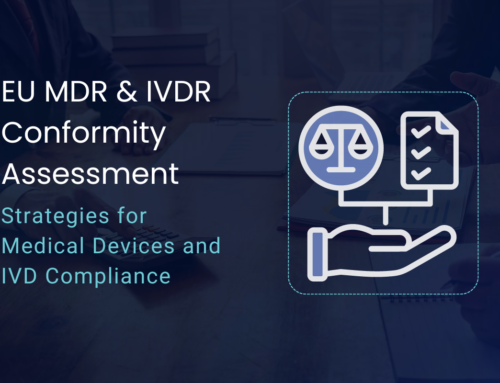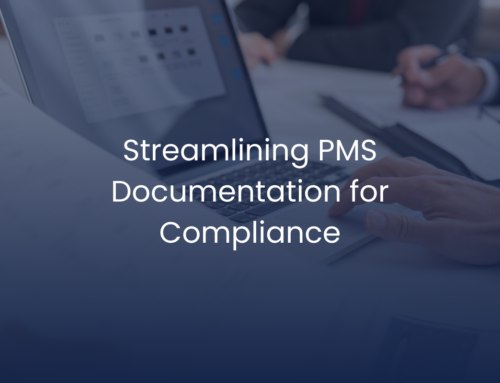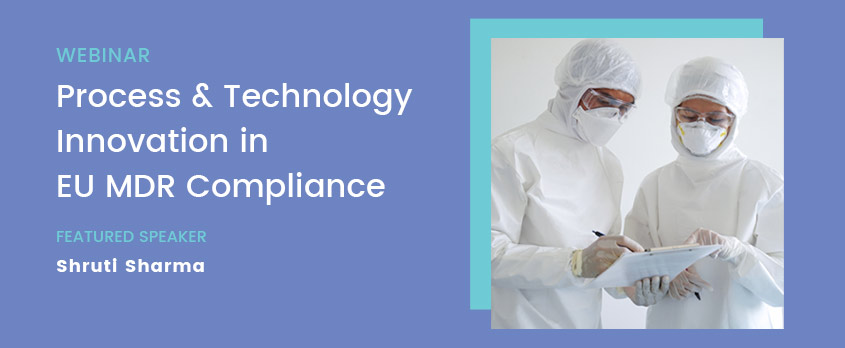
Technology Innovation in EU MDR Compliance
Shruti Sharma has 5 years of experience in Medical writing, specializing in Clinical Evaluation Plans (CEPs), Clinical Evaluation Reports (CERs), Summary of Safety and Clinical Performance (SSCP) Reports, and Post-Market-Surveillance Reports (PMSRs). She has been the lead author for Clinical Evaluation Plans and Reports (CEP/CER) for device families across a wide range of therapeutic areas – endodontics, prosthodontics, diagnostic imaging, interventional neuroradiology, cleaning, disinfection, and sterilization devices, in addition to Software as a Medical Device (SaMD).
During our inaugural Medical Device Virtual Summit – 2021, Shruti Sharma presented a thought-provoking session titled “Process & Technology Innovation in EU MDR Compliance.”
Why should you watch this video/read the transcript?
- Demystify the requirements of the EU MDR, and in particular, the ongoing PMS requirements for various reports such as PMCF plans/reports, Clinical Evaluation plans/reports, SSCPs, etc.
- Understand how businesses are approaching the MDR as an opportunity for business transformation
- Learn to leverage a single source of truth to harmonize data across various documents including your IFU, technical file, and post-marketing documentation
- View an overview and demo of our cloud-based EU MDR compliance platform which can reduce the time it takes to author your clinical documentation by nearly 20%
A full transcript of Shruti’s presentation is available to download (and to read below) and just press play to watch the clip now.

Claim Your Free EU MDR Checklist Now!
Make sure you and your business are compliant with the new EU MDR. Get our 23 page checklist for actionable technical documentation requirements.
EU MDR – Major Challenges
The MDR has had an impact on the people, processes, and tools required by an organization. Manufacturers need to be equipped with specialized tools to help them work more efficiently. There is an evident increase in the cost of operations. Reviews and interactions with the notified body are much more comprehensive now as well. There are significant changes surrounding UDI with an increased responsibility on all economy operators. There is also an increased emphasis on post-market surveillance – this includes proactively monitoring device performance for re-certification and the annual safety updates for high-risk class devices.
Internal data management needs to be more robust with higher traceability. The same set of data will feed into multiple reports that are now required by the MDR, and essentially, it means that there does not need to be a single source of truth. External data, just like the internal data sets, are also multi-use. Data extraction from external sources like literature databases need more efficiency in terms of building a uniform data set.
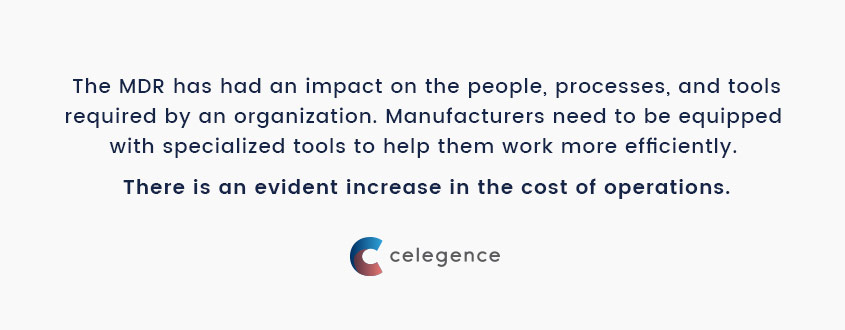
MDR Challenges – What Manufacturers Need To Do
Enhance: Manufacturers need to enhance the skillsets of their current teams. They need to look at their RA and QA teams and understand how they can be upskilled to fully understand the MDR requirements and are able to implement these changes.
Revise: Manufacturers need to look back into their existing processes surrounding clinical evaluations, PMS, and risk management to see if any of these processes need to be revised.
Appoint: There is also the appointment of the PRRC role within the organization, which is the person responsible for regulatory compliance.
Reassess: Manufacturers need to reassess clinical data for the devices which were already there in the market. You need to assess whether the test data is sufficient, or if additional testing is required, or maybe if a PMCF plan is necessary.
Establish: They also need to establish processes related to data/information collection, and this is important because requirements surrounding the UDI are in a very structured format, whereas the reporting requirements for reports like the PMS templates, Clinical Evaluation Templates, SSCP Templates etc., are slightly more freeform. There are guidelines in place, but manufacturers still need to create their own templates.
Align: Ultimately manufacturers need to align the processes and technologies for information exchanges in the EUDAMED database. Would it either be manual or would it be automated? This is something that needs to be looked into.
Data Sources for EU MDR Reports – Internal
Internal data sources usually come from the technical file, but the technical file itself is enormous. The kind of data sources that we are interested in comes from the IFUs/user manuals, your verification and validation tests, any preclinical studies or clinical investigations, claims, clinical benefits of the device, pre-market surveys, or VOCs that they were conducted. Additionally this can include all of the risk documents, especially the FMEAs, the device claims matrix, and any previous clinical evaluations.
Post market data that we look at consists of the sales data, any complaints data, any corrective and preventive actions, field actions or recalls, health hazard evaluations, vigilance reports, trend reports etc. If any of these occur they need to be included in these reports.
For external data sources, they can be categorized under three major headings. The first one can be your literature sources. Then you have clinical trial registries. The third one is your adverse events and safety databases. Adverse events can be further branched out into specific cybersecurity databases if your device is a software.
This list is not so exhaustive. There can be many data sources depending on the device type and the risk category it falls in. Individual sections of the reports that you see on the left and the presentation of data in these reports may change, but a major chunk of information that goes into each of these reports is fairly common.

Claim Your Free EU MDR Checklist Now!
Make sure you and your business are compliant with the new EU MDR. Get our 23 page checklist for actionable technical documentation requirements.
MDR Challenges: Handling Internal and External Data
Versatility of data is great, but how do you track it? How do you ensure that all pivotal data captured while creating one report has also been transferred to another? Manufacturers usually have a very robust QMS system for handling their internal data. They have a systematic approach for handling and updating their internal documentation. However, systematically handling and keeping track of data gathered from external sources is a challenge. Mostly because there are multiple sources of information like we saw, and no two sources give the same kind of interaction to the user.
Let’s look at an example of literature sources. Now, no two sites that you see will have the same interface, and the format of data that is exported from these sites can vary. There is a need for a systematic process to gather and store information from these databases as a uniform data set.
Notified bodies are now interested in how you gathered your information and what strategy you follow to get to your pivotal data. One must also keep in mind the intended audience for this report and how to present data in a way which is clear and easy to understand.
I’d also like to highlight that every update that you make to your report, you will have a new set of data gathered for that review period. Notified bodies are focusing on clinical evidence and support for the device or the device technology. We’ve had instances where the notified bodies asked us to expand the date range of the searches. Instances like these where you have to search, consolidate, and track large data sets from multiple sources are very labor intensive and a huge resource burden.
EU MDR – An Opportunity for Business Transformation
It is 2021. Your end user is educated, curious, and has access to a lot more resources and information. You have increased awareness of the device status and how long the device has been on the market. Additionally, if it was ever recalled or had any field safety corrective actions against it, that can be accessed by the public. This publicly available information will allow users to make more informed decisions when choosing a device, or when a device is recommended to them.
Data published on EUDAMED can provide manufacturers a competitive advantage. They now have access to competitor data that they could not view before. One can use this data to guide and improve their devices design and risk calculations.
An increased emphasis on PMS will improve the manufacturer’s understanding of their device’s clinical benefits. Apart from meeting compliance requirements, we are looking at an increased level of safety for devices, and the industry overall.
There are also commercial advantages to this. Legacy devices that did not require clinical trials are now required to provide safety data. It may not be financially worth the investment to bring them to MDR standards based on low sales or profitability.
For the UDI – UDI aligns the manufacturers and other stakeholders in the supply chain to reduce counterfeit products. They can improve inventory management, even identify flawed devices, reduce medical errors, provide more information to patient treatment, facilitate worldwide medical device identification, and also give manufacturers an increased lead time to identify issues. These benefits may be utilized in the long-term, but in the short term, a lot of companies are still struggling to be ready for the EU MDR.
As a manufacturer, it is wise to consider a consulting firm or regulatory service provider to overcome these challenges.
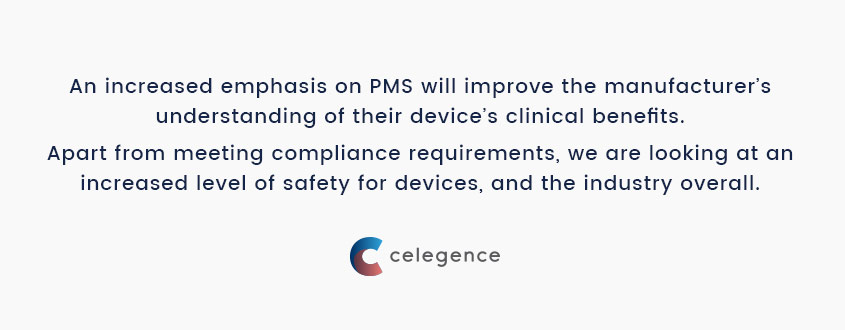
Addressing MDR Challenges: Partnering with an External Vendor
Manufacturers may consider offloading several of the regulatory workloads to external vendors and consultants. External vendors can help you by starting with a MDR gap analysis. They can also provide you with consulting regarding EU-UDI, EUDAMED, PMS, and other topics.
They can help you with medical writing tasks which can be technical file remediations, authoring CERs, PMSRs, SSCPs, and other documents. They can help you with global medical device registrations and global regulatory intelligence consulting.
Manufacturers can also leverage technology to bring efficiency to their regulatory processes. Technology can help maintain the reliability and consistency of the data. For example, technology can assist you with your technical validations, electronic submissions, planning, and governance processes. It’ll help you manage your entire product portfolio. The best part is that it is customizable. You can always alter it to suit your needs and requirements. The technology provider can also explore your current processes and optimize it by automating certain tasks.
EU MDR – An Opportunity for Business Transformation
It is 2021. Your end user is educated, curious, and has access to a lot more resources and information. You have increased awareness of the device status and how long the device has been on the market. Additionally, if it was ever recalled or had any field safety corrective actions against it, that can be accessed by the public. This publicly available information will allow users to make more informed decisions when choosing a device, or when a device is recommended to them.
Data published on EUDAMED can provide manufacturers a competitive advantage. They now have access to competitor data that they could not view before. One can use this data to guide and improve their devices design and risk calculations.
An increased emphasis on PMS will improve the manufacturer’s understanding of their device’s clinical benefits. Apart from meeting compliance requirements, we are looking at an increased level of safety for devices, and the industry overall.
There are also commercial advantages to this. Legacy devices that did not require clinical trials are now required to provide safety data. It may not be financially worth the investment to bring them to MDR standards based on low sales or profitability.
For the UDI – UDI aligns the manufacturers and other stakeholders in the supply chain to reduce counterfeit products. They can improve inventory management, even identify flawed devices, reduce medical errors, provide more information to patient treatment, facilitate worldwide medical device identification, and also give manufacturers an increased lead time to identify issues. These benefits may be utilized in the long-term, but in the short term, a lot of companies are still struggling to be ready for the EU MDR.
As a manufacturer, it is wise to consider a consulting firm or regulatory service provider to overcome these challenges.
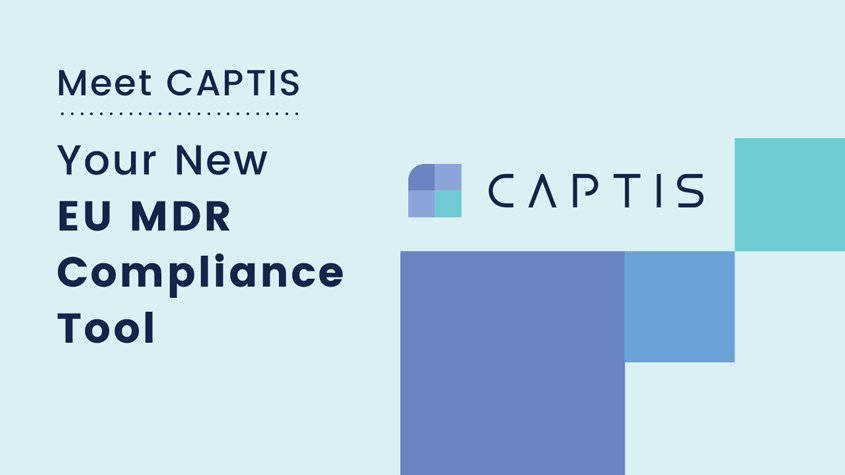
CAPTIS Technology Platform: Overview of Key Features
I would like to introduce you to the CAPTIS EU MDR technology platform, which was developed keeping in mind the manufacturer’s perspective for MDR compliance.
Some key features offered by this technology solution include:
- Support for document lifecycle management
- Improve collaboration via cloud integration
- Predefined reports, which can be generated for user roles
- Integration with literature databases with simple article management
- Automation for activities like data consolidation, formatting, etc.
- Integration with the TPLC database for PMS information
Conclusions
- The primary implications of the EU MDR are the significant remediation costs, and the need for skilled technical resources.
- The medtech industry should be looking across their entire product life cycle to see if there are any internal process areas that can be updated to increase efficiency.
- There are many new requirements that will benefit the medtech industry in the long-term. For example, portfolio optimization or traceability through UDI, and how manufacturers can gain a competitive edge from publicly available data.
- There is a significant influx of information from internal and external sources. This may seem to be a challenge, but it will ultimately allow manufacturers to make better decisions for their devices. There are several areas where automation and technology can reduce manual activity and improve the management of the documents required for ongoing EU MDR Compliance.
- Our technology roadmap includes features that assist our clients in overcoming challenges related to report creation and maintenance.
- In the near future, manufacturers can consider leveraging external vendors and benefit from increased process efficiency, improved deliverable quality, and ensured compliance.
